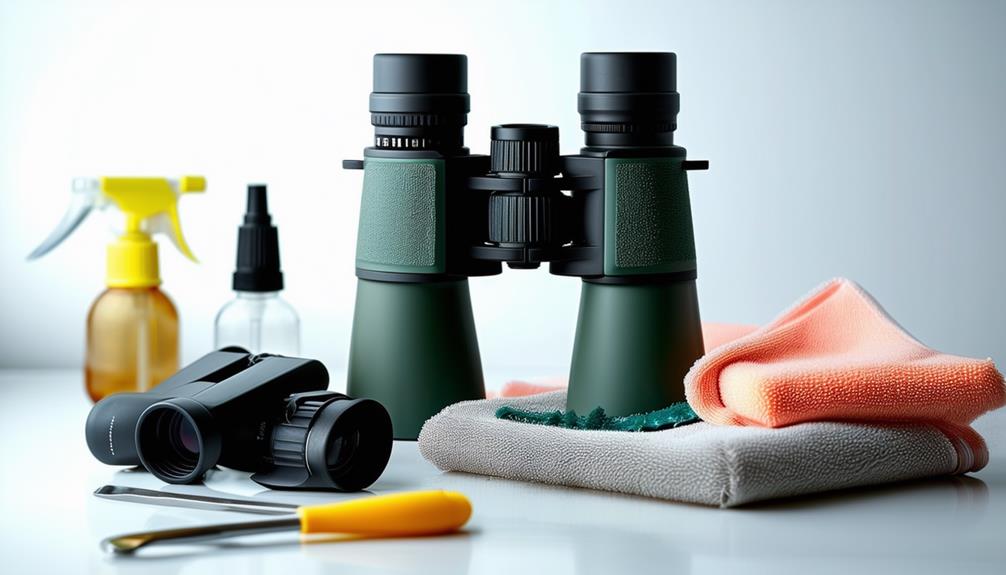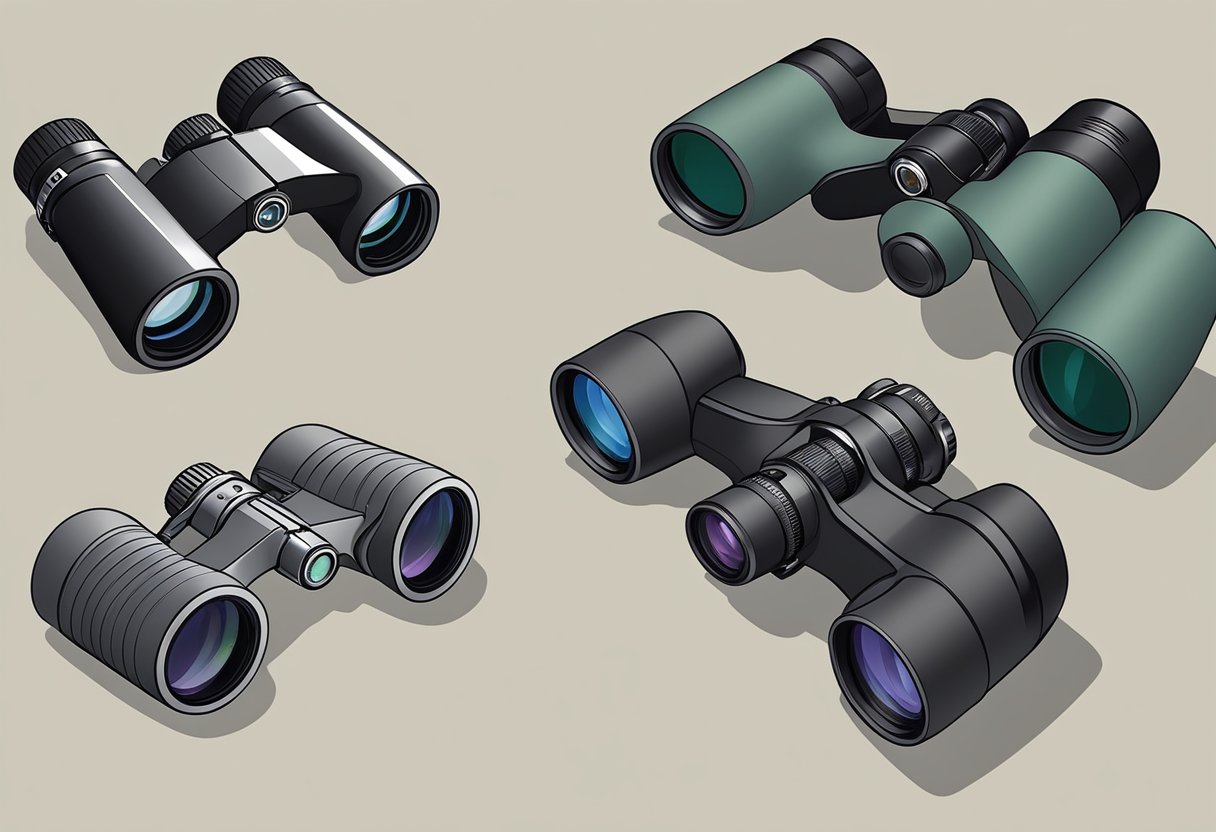Understanding Binocular Specifications: Magnification, Field of View, and More
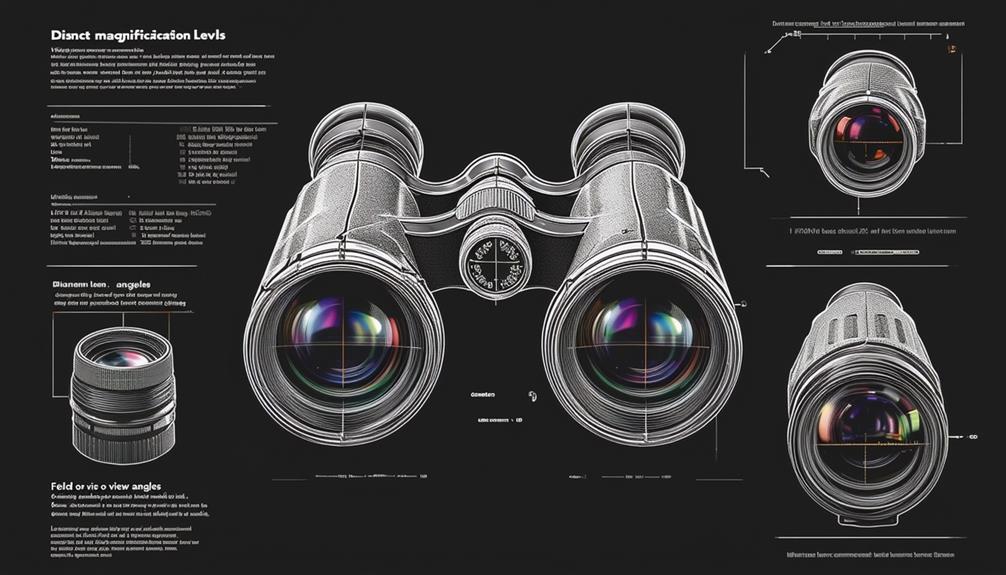
When selecting binoculars, understanding their specifications is crucial. Magnification indicates how much closer objects will appear, but it's a trade-off; higher magnification can narrow your field of view, making it harder to locate objects.
The field of view, measured in feet at 1,000 yards, determines the width of the area you can see. These two factors can significantly impact your experience, but there are additional elements to consider.
The objective lens diameter, exit pupil, and brightness all play roles in different lighting conditions and activities. Understanding these components will guide you to the ideal pair of binoculars.
Magnification
When choosing binoculars, it's crucial to understand how magnification affects your viewing experience. Magnification indicates how much closer objects will appear through the lenses. For instance, binoculars with 8x magnification make an object appear eight times closer than with the naked eye. Common magnification levels range from 8x to 12x, catering to various activities.
Higher magnification, like 12x, has trade-offs, such as a reduced field of view—the visible area seen through the binoculars. Higher magnification narrows this field, limiting your ability to see a wide landscape or follow fast-moving subjects.
On the other hand, lower magnification, such as 8x, provides a wider field of view, enabling you to see more of your surroundings. While higher magnification brings distant objects closer, it can also result in a shakier image, often requiring additional stabilization. Balancing magnification and field of view is essential for selecting the right binoculars for your needs.
Field of View
The field of view refers to the width of the image you see through binoculars, which is crucial for tracking moving subjects like birds or sports action. A wider field of view makes it easier to locate and follow fast-moving objects. Typically, the field of view is measured in feet at 1,000 yards, providing an idea of how much scenery you can see without moving the binoculars.
A wide field of view is particularly beneficial for birdwatching, as it allows you to see a broader area and react quickly to sudden movements. However, as magnification increases, the field of view tends to decrease. This trade-off means you need to balance magnification with the desired field of view based on your specific needs.
Manufacturers often list the field of view in degrees or feet at 1,000 yards. For example, birding binoculars typically offer a field of view ranging from 5.5° to 8.5°, which translates to different coverage areas:
| Magnification | Field of View (°) | Field of View (feet at 1,000 yards) |
|---|---|---|
| 8x | 8.0° | 420 feet |
| 10x | 6.5° | 340 feet |
| 12x | 5.5° | 288 feet |
Choosing the right field of view helps you get the comprehensive image you need for any activity.
Objective Lens Diameter
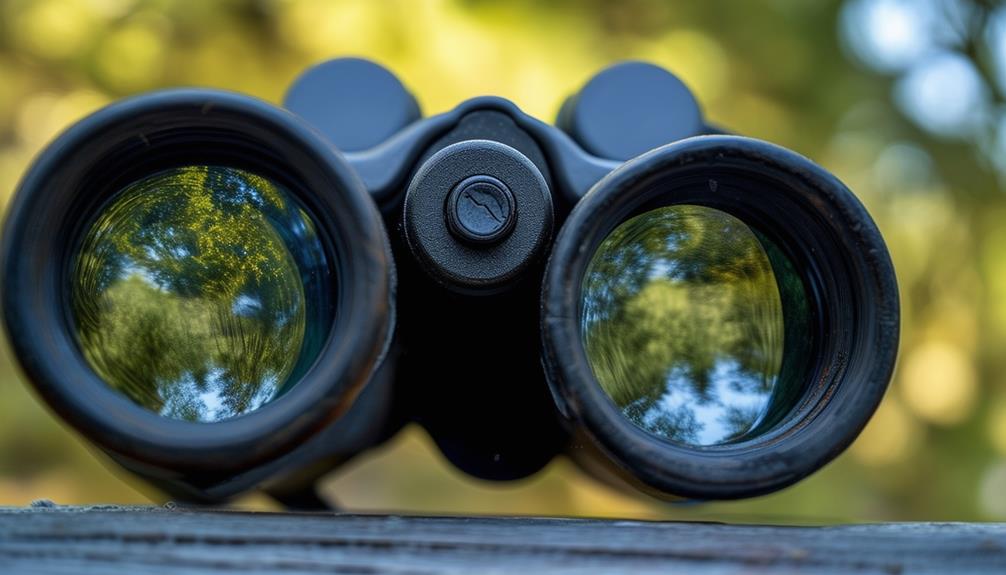
Choosing the right objective lens diameter is crucial for optimizing your binoculars' performance in various lighting conditions. Larger lenses, such as 42mm or 50mm, can gather more light, resulting in brighter images, particularly in low-light scenarios like dawn or dusk.
However, it's important to balance the benefits of a larger objective lens with the associated increase in weight and bulk. While larger lenses offer superior image clarity and brightness, they can make the binoculars heavier and less portable. If you plan to use your binoculars for extended periods or during hikes, you might prefer a smaller objective lens diameter to keep them lightweight and manageable.
The objective lens size directly affects light intake, which in turn influences image quality. Higher light intake results in crisper, more vivid images, enhancing your viewing experience. Therefore, if your primary activities occur in low-light conditions, a larger objective lens diameter can be advantageous. Consider your specific needs and preferences to find the ideal balance between light transmission and ease of use.
Exit Pupil and Brightness
When choosing binoculars, consider the exit pupil, calculated by dividing the objective lens diameter by the magnification. A larger exit pupil results in a brighter image, which is particularly important in low-light conditions. Focusing on this factor ensures optimal performance in various lighting environments.
Exit Pupil Calculation
Calculating the exit pupil of your binoculars is essential for understanding the brightness of the image you'll see. This measurement is crucial because it directly impacts the light entering your eyes, especially in low-light conditions. You calculate the exit pupil by dividing the effective diameter of the objective lens by the magnification. For instance, if you have binoculars with an objective lens diameter of 50 mm and a magnification of 10x, the exit pupil is 5 mm.
A larger exit pupil results in a brighter image, which is vital for activities like stargazing or wildlife viewing at dawn or dusk. Understanding this can significantly improve your viewing experience and help you choose the right binoculars for different lighting conditions.
Here's a breakdown in table form:
| Objective Lens Diameter (mm) | Magnification | Exit Pupil (mm) |
|---|---|---|
| 50 | 10 | 5 |
| 42 | 8 | 5.25 |
| 32 | 8 | 4 |
| 25 | 10 | 2.5 |
| 56 | 7 | 8 |
Understanding the exit pupil can help you select binoculars that are best suited for varying lighting conditions, ensuring a brighter and clearer image.
Low-Light Performance
To enhance your binoculars' low-light performance, it's crucial to understand the significance of the exit pupil and its effect on image brightness. The exit pupil is determined by dividing the effective diameter of the objective lens by the magnification. This value directly impacts the brightness of your view, especially in poor lighting conditions.
A larger exit pupil allows more light to reach your eyes, providing a brighter image, which is essential for activities such as dawn, dusk observations, or nighttime stargazing. By opting for binoculars with a larger effective diameter, you increase the lenses' light-gathering capability. This not only boosts brightness but also improves resolution, resulting in sharper and more detailed images.
For optimal low-light performance, select an exit pupil size that matches or exceeds the dilation of your pupils in the dark, generally around 5 to 7 millimeters for most adults. Understanding the interplay between exit pupil, effective diameter, and magnification will guide you in choosing binoculars that excel in low-light conditions. Prioritizing these factors ensures that your binoculars provide maximum brightness and clarity when visibility is low, enhancing your overall viewing experience.
Optimal Viewing Experience
For the best viewing experience with binoculars, it's crucial to select a pair with an exit pupil suited to your low-light needs. The exit pupil, which is the diameter of the beam of light that exits the eyepiece, is calculated by dividing the effective diameter of the objective lens by the magnification. A larger exit pupil results in a brighter image, which is essential for viewing quality in dim conditions such as dawn or dusk.
Brightness is a key factor for binocular performance, especially for activities like stargazing or wildlife observation at night. A larger objective lens diameter gathers more light, enhancing both image resolution and brightness, thereby improving the overall performance and viewing quality of your binoculars.
Here's a quick reference table to help you understand the relationship between binocular specifications and exit pupil:
| Magnification | Objective Lens Diameter (mm) | Exit Pupil (mm) | Field of View (degrees) | Brightness |
|---|---|---|---|---|
| 8x | 40 | 5.0 | 7.5 | High |
| 10x | 50 | 5.0 | 6.5 | High |
| 12x | 60 | 5.0 | 5.5 | High |
| 8x | 25 | 3.1 | 7.0 | Medium |
| 10x | 30 | 3.0 | 6.0 | Medium |
Understanding and optimizing these binocular specifications ensures you get the best possible viewing experience, regardless of lighting conditions.
Lens Materials and Coatings

When selecting binoculars, you'll encounter various lens materials and coatings that significantly affect performance. High-quality glass and specialized optical coatings, such as Fully Multi-Coated (FMC) and Dielectric, enhance light transmission and reduce chromatic aberration. Anti-glare and protective coatings are also essential for minimizing glare and ensuring the lenses' durability.
Types of Optical Coatings
Optical coatings like Fully Coated (FC), Multi-Coated (MC), and Fully Multi-Coated (FMC) significantly enhance light transmission and image clarity in binoculars. These coatings, when applied to the objective lenses, minimize reflections and allow more light to pass through, resulting in brighter and sharper images. High-quality optical coatings also reduce chromatic aberration, ensuring accurate and vivid colors.
Dielectric and Phase coatings are particularly effective in refining color fidelity by addressing the slight misalignment of light waves. These coatings help reduce color fringing and enhance detail. Protective coatings on lenses are essential as well; they guard against scratches, water damage, and debris accumulation, extending the life of your binoculars and ensuring consistent performance.
Additionally, some coatings are designed to repel water and dirt, making maintenance easier, which is particularly beneficial for outdoor use in varying weather conditions. Investing in binoculars with quality coatings can make a significant difference in your viewing experience. These coatings not only improve optical performance but also provide durability and ease of maintenance. Therefore, when choosing binoculars, consider the importance of advanced optical coatings.
Glass Quality Impact
High-quality glass and specialized lens coatings in binoculars significantly enhance your viewing experience by delivering sharper, brighter images. When selecting binoculars, prioritize those with advanced glass compositions, as this ensures optimal optical performance. Superior glass minimizes image distortion and improves clarity, providing a crisp, detailed view.
Lens coatings are equally crucial. These coatings reduce internal reflections, thereby heightening image quality and enhancing low-light performance. Whether using binoculars at dawn, dusk, or in dense forests, coated lenses enable clearer vision in dim conditions.
The objective diameter of the binoculars also impacts the field of view. A larger objective diameter allows more light to enter, which, when paired with high-quality glass and effective lens coatings, results in a wider, brighter field of view. This is especially beneficial for activities like bird watching or stargazing, where seeing the entire scene is essential.
Understanding the impact of glass quality and lens coatings helps you choose binoculars that offer superior optical performance, ensuring every detail stands out during your observations. Prioritize these factors for an enhanced viewing experience.
Reflection Reduction Techniques
To enhance image quality, binoculars employ advanced reflection reduction techniques using specialized lens materials and coatings. These enhancements ensure the clearest and brightest views possible. Fully Multi-Coated (FMC) lenses are crucial for minimizing reflections across the entire visible spectrum, allowing more light to pass through the lenses and resulting in brighter, sharper images.
Anti-glare coatings are another vital component, designed to optimize light transmission and significantly enhance the overall brightness of your view. These coatings minimize light loss due to reflections, ensuring you capture more detail.
Dielectric and phase coatings on prisms are essential for reducing chromatic aberration and ensuring accurate color reproduction, resulting in more true-to-life images. Protective coatings play a key role in shielding your binoculars from scratches, dust, and moisture, thereby maintaining long-term durability and performance.
| Technique | Purpose |
|---|---|
| Fully Multi-Coated (FMC) | Reduces reflections, improves clarity |
| Anti-glare coatings | Optimizes light transmission |
| Dielectric coatings | Enhances color accuracy |
| Phase coatings | Reduces chromatic aberration |
| Protective coatings | Protects against scratches, dust, moisture |
These reflection reduction techniques collectively contribute to superior image quality and binocular longevity, ensuring a reliable and pristine viewing experience.
Prism Type
When selecting binoculars, understanding the distinctions between Porro and Roof prisms is crucial for optimizing your viewing experience. Each prism type has unique characteristics that affect the binoculars' field of view, optical performance, and practicality.
Porro prisms, known for their characteristic zigzag design, typically offer a wider field of view and enhanced depth perception. These attributes make them ideal for activities such as birdwatching and stargazing, where a broad, immersive view is desired.
In contrast, Roof prisms feature a more streamlined and compact design, making them easier to handle and more portable. This can be especially advantageous for trekking and other outdoor activities. However, the precision required in manufacturing Roof prisms often makes them more expensive compared to Porro prisms.
While optical performance isn't solely determined by the prism type, the choice between Porro and Roof prisms can affect the binoculars' dimensions, weight, and ease of use. By understanding these differences, you can make an informed decision that best meets your specific needs, ensuring an optimal viewing experience.
Eye Relief and Close Focus
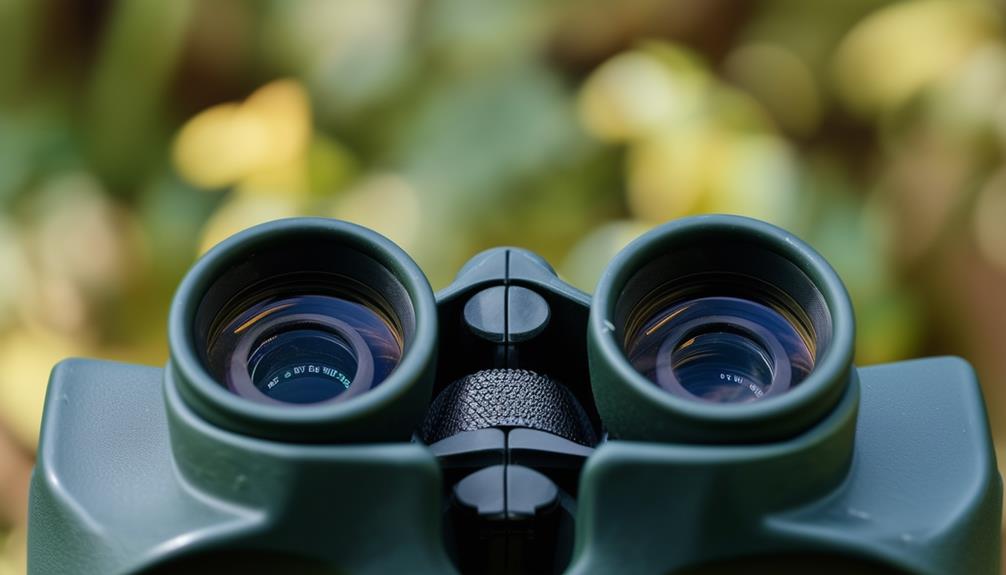
Understanding eye relief and close focus is crucial for optimizing your binocular experience. Eye relief refers to the distance between the eyepiece and your eye. For eyeglass wearers, longer eye relief is necessary, typically around 14-15mm, to ensure you can see the full field of view comfortably. Insufficient eye relief can cause discomfort and eye strain during prolonged use, making it essential to choose the right specification for comfortable viewing.
Close focus is the minimum distance at which binoculars can clearly focus. This feature is significant for observing nearby subjects like birds, insects, or flowers in detail. For an optimal experience, select binoculars with a close focus under 2 meters. Models like the Engage EDX, with a close focus of 1.8 meters, enable you to observe nearby subjects with remarkable clarity and detail.
Conclusion
Understanding binocular specifications like magnification, field of view, and other key factors ensures you make an informed choice for your viewing needs. Balancing these elements guarantees the best experience, whether you're birdwatching, stargazing, or enjoying a sports event. Consider objective lens diameter, exit pupil, brightness, lens materials, prism type, and eye relief. With this knowledge, you're ready to select the perfect binoculars and enhance your viewing adventures.

